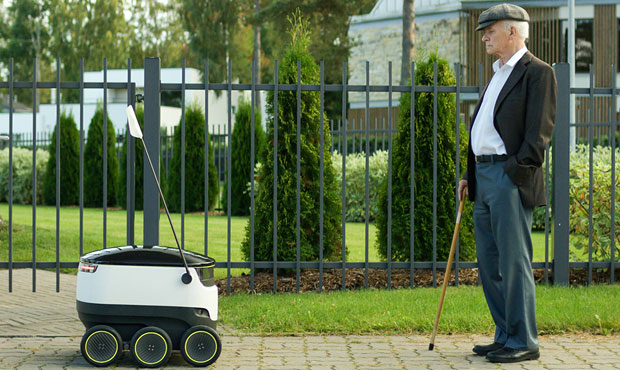Autonomous delivery robots will be able to travel on sidewalks, crosswalks and shared-use paths throughout the Commonwealth of Virginia this summer.
Gov. Terry McAullife recently signed a law permitting the use of Starship Technologies’ Personal Delivery Devices, or PDDs. The six-wheeled robots, which resemble coolers, are designed to deliver parcels, groceries and food within a two-mile radius in 15-30 minutes.
The PDDs weigh about 40 pounds and can carry a workload of up to 20 pounds. They travel at 4 mph.
They must obey all traffic and pedestrian control devices and signs. They must display a plate or marker identifying their owner’s name and contact information, as well as a unique identifier number. Transport of hazardous materials, substances or waste is not permitted under the new law.
The PDDs, which run on rechargeable Li-Ion batteries, must have brakes. They can’t weigh more than 50 pounds, or travel faster than 10 mph.
While the PDDs can travel autonomously, Virginia requires that a human operator actively control or monitor their navigation and operation. Starship’s PDDs are controlled remotely through a fleet management app.
Virginia’s law is the first in the United States to govern autonomous delivery robots.
“Most states have laws prohibiting moving vehicles on sidewalks, but they didn’t take into account slow-moving autonomous mobile robots when they were written,” noted Philip Solis, a research director at ABI Research.
“Therefore, new laws are required,” he told TechNewsWorld.
Bills along similar lines reportedly have been proposed in Florida and Idaho.
Delivery Robots: The Next Necessity?
“It’s not a question of if [delivery robots are] coming, it’s a question of how soon,” said Jim McGregor, a principal analyst at Tirias Research.
Delivering goods “is one of those applications where it’s often difficult to hire people — and sometimes impractical as the minimum wage increases,” he told TechNewsWorld. “Eventually it’ll just be cheaper and more reliable to use drones for tasks like this.”
Starship claims its robots have covered 10,000 miles in tests or in making actual deliveries in 56 cities in 16 countries worldwide. Companies testing the robots include Just Eat, Europe’s largest food delivery company; Swiss Post, Switzerland’s national postal service; Hermes Parcel Delivery and retailer Metro Group in Germany; and the food delivery startup Pronto, based in London.
Starship robots are being tested in the United States in Redwood City, California, by DoorDash; in San Francisco by Dispatch; and in Washington, D.C., by Postmates.
Domino’s last year began a trial of an autonomous pizza delivery robot in New Zealand.
The battery-powered four-wheeled Domino’s Robotic Unit, or DRU, reportedly has a range of 12 miles and is about one meter high. It has different compartments to keep beverages cool and pizzas hot, and can carry up to 10 pizzas.
On-board sensors help the robot navigate obstacles.
Privacy Infringement and Other Concerns
Starship PDDs’ use of high-definition video cameras for location triangulation and tracking might raise fears of an invasion of privacy, or of their being used for surveillance by law enforcement or government agencies.
“The use of such information should be no different than using the information from traffic or security cameras used in public locations if the robots don’t infringe on people’s legal rights, such as by entering their homes,” McGregor said. “However, there will always be some areas of ambiguity.”
There’s also the fear that robots could be used for terrorism-related activities, but “whatever we can imagine possible with these robots is also likely with humans,” McGregor pointed out, adding that “it’s better to address the problem rather than the outcome.”























































